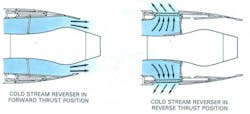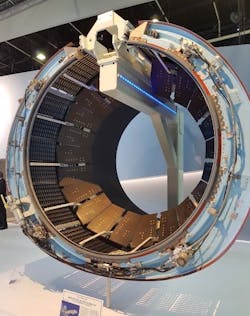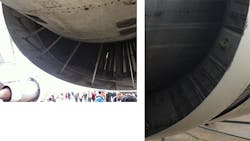How to Specify the Right Flexible Shafts for TRAS
Thrust Reverser Actuation Systems redirect aircraft engine thrust immediately after landing to brake. On commercial jets, these systems provide critical safety and maneuverability to pilots. Failure to deploy correctly during a landing could cause unsafe turning as an engine on one wing brakes while the other continues forward thrust. Even more dangerously, a poorly designed TRAS can rattle out of place during flight, effectively disabling an engine thousands of feet from the ground. Therefore, as is the case with most aerospace engineering, excellence in TRAS design is a necessity. Understanding the characteristics of a key functional component—the flexible shaft—is vital to a configuring a successful TRAS. As an engineering team begins the initial design phase for a TRAS, it should consider what makes flexible shaft technology appropriate for aircraft engines, and what specifications best serve the application.
Flexible Shafts in Basic TRAS Designs
Commercial aircraft fly on Larger Turbo Fan gas turbine engines, and Thrust Reverser Actuator Systems operate by redirecting the cold “bypass” air, as shown in Figure A. In order to achieve this redirection, a series of four to six actuators moves the rear of the aft cowl backward to expose a matrix of openings on the side of the turbine (Figures B and C) while simultaneously blocking the bypass airflow (Figures D, E, and F), thus forcing the air through the mid-turbine exposure.
Figure A
Figures B and C
Figure D
Figures E and F
The actuators must move together in a synchronized fashion; a non-synchronized deployment can lead to the system jamming. This results in asymmetrical braking, affecting the pilot’s ability to control the aircraft. Both principle system types address this consideration with flexible shafts, so the lifetime torsional deflection of flexible shafts is an important characteristic for the successful operation of any commercial TRAS. Engineers must control the deflection angle of these flexible shafts in order to ensure actuators deploy and stow fully. Managing this element of the TRAS design plays a critical role in avoiding inadvertent deployment during flight by correctly locking into the stow position.
In a hydraulic TRAS system, these flexible shafts are passive—their sole function is to ensure the actuators deploy and stow synchronously to prevent panels from jamming the system. In this design, the flexible shafts are contained within the hydraulic tubes that deploy the system, and so are lubricated by the hydraulic fluid. These systems generally support lower torsional loads.
Alternatively, motor-driven systems rely on flexible shafts both to ensure synchronization and to actually drive deployment. In this design, one or more electric motors generate torque, and flexible shafts are the only means of transmitting that torque from one actuator to the next. These systems offer higher torques than their hydraulic counterparts.
By altering the shaft radius, a flexible shaft’s torque characteristics can be altered. An S.S. White comparison of these two factors is available here.
Engineers must also account for load cases when designing flexible shaft systems for success, as different load cases can impact the useful life of these parts in different numbers of operation cycles. Key load cases to factor into the design process include Normal Operating (stow/deploy), Rejected Take Off [RTO] (deploy), Limit Load (proof/acceptance test load), and Ultimate Load (failure/Ultimate Torsional Strength UTS).
Key Flexible Shaft Characteristics for TRAS Applications
Beyond the basic considerations of load, deflection endurance, and fatigue characteristics, a variety of additional flexible shaft characteristics define the components’ utility in TRASs. These can be organized into three categories: Performance, Assembly/Material, and Installation.
Correctly positioning actuators is a necessary function of flexible shafts in these systems. This positioning depends mechanically on the angular position between the ends of each shaft. Therefore, angular deflection / torsional stiffness, which is proportional to applied torque and flexible shaft length, asserts itself as a key performance characteristic.
Other important performance characteristics deal with stresses on the system. For example, TRASs must accommodate shock from a variety of sources, including “back driving” or static torque loads caused by system architecture or aerodynamic effect and “torque spikes” at the end of the stroke when the system hits its end stops when a system’s inertia may be absorbed by the torsional elasticity of its flexible shafts. Depending on TRAS configuration, flexible shafts’ ability to absorb shock loads can prove highly advantageous.
Likewise, change in angular deflection over time should be controlled, as wear over a number of cycles can be expected to add additional rotational angular detection. Lubrication can lessen this consequence of repeated use. However, engineers should consider another factor before specifying a lubricant: operating temperature. Grease, for example, exhibits potential sticking effects at low temperatures—threatening to significantly increase the torque required to actuate the system and cause shafts to vibrate—although S.S. White engineers have developed mitigation techniques for such a scenario. Nevertheless, some vibration is unavoidable, including in flexible shafts’ static position, and must be considered in the engineering process as well.
To best integrate flexible shafts into a cohesive and durable system, engineers must consider the long term and design with several material and assembly characteristics in mind.
Firstly, materials should be selected with the following in mind: electrical bonding path, in case of a lightning strike; tribological (bearing) couples, with suitable materials for bearings designed to contact each other; galvanic couples, with materials that guard against long term corrosion; etc. Different materials offer a number of distinct benefits for certain applications and can affect how flexible shaft constructions operate within a TRAS. More fundamentally, any system using flexible shafts must competently fit those shafts into an overall assembly.
For this reason, engineers must give careful consideration to the radial clearance between the shaft and the casing. This clearance will limit the amplitude of the helix, and also the wavelength, of the flexible shafts. This is often influenced by the support clamp spacing, and by the bending stiffness of the casing due to the tendency of a flexible shaft to helix during operation.
Then, when determining the length of the flexible shafts in a design, engineers must factor in the likely routing of the shaft compared to the routing of its casing. The centerline path of the installed shaft may be longer than the housing, meaning the shaft should be longer in turn. In some circumstances, a device may be needed to retain the shaft in its casing to ensure its correct positioning.
S.S. White shafts can feature a variety of fitting types to minimize the chances of incorrect installation in a TRAS.
Of course, the best designed system will fail if incorrectly or insecurely installed. If loose flanges are specified, for example, the engineering team may decide to develop a feature to retain them and prevent their falling from one end to another. Installation can also be foolproofed, by designing assemblies of differing lengths. When this is impossible, as in the many cases for which both shafts with dominant characteristic in clockwise and counterclockwise directions are required to be of identical length, creative engineers may select differing fitting types—square and hexagon cross-section fittings, or fittings with alternate numbers of spline teeth—to prevent a detrimental incorrect installation. Another option to design for quality installation involves a trade-off. Assemblies can be “locked in” to aid installers, and prevent inner flexible shafts from separating from their casing, but this can inhibit maintenance and examination.
Flexible Shaft Experts Provide TRAS Engineering Insight
Whether designing a hydraulic or motor-driven system, TRAS engineering teams must consider an array of flexible shaft characteristics early in the design process. Engineers at S.S. White, a global leader in flexible shaft technology, provide valuable expertise on the intricacies of flexible shaft performance and assembly and can help specify the ideal flexible shaft solution for a specific application the first time. To ensure safe and efficient operation, engineers should consider torsional, wear, and assembly attributes among others—optimally, with insight from industry-leading application engineering professionals.






